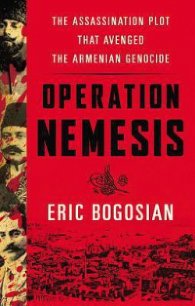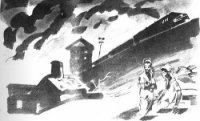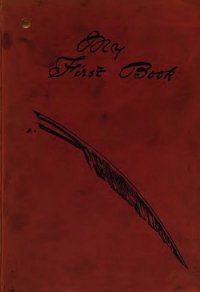Operation Nemesis: The Assassination Plot that Avenged the Armenian Genocide - Bogosian Eric (мир книг .txt) 📗

Жалоба
Напишите нам, и мы в срочном порядке примем меры.
Operation Nemesis: The Assassination Plot that Avenged the Armenian Genocide - Bogosian Eric (мир книг .txt) 📗 краткое содержание
A masterful account of the assassins who hunted down the perpetrators of the Armenian Genocide
In 1921, a tightly knit band of killers set out to avenge the deaths of almost one million victims of the Armenian Genocide. They were a humble bunch: an accountant, a life insurance salesman, a newspaper editor, an engineering student, and a diplomat. Together they formed one of the most effective assassination squads in history. They named their operation Nemesis, after the Greek goddess of retribution. The assassins were survivors, men defined by the massive tragedy that had devastated their people. With operatives on three continents, the Nemesis team killed six major Turkish leaders in Berlin, Constantinople, Tiflis, and Rome, only to disband and suddenly disappear. The story of this secret operation has never been fully told, until now.
Eric Bogosian goes beyond simply telling the story of this cadre of Armenian assassins by setting the killings in the context of Ottoman and Armenian history, as well as showing in vivid color the era's history, rife with political fighting and massacres. Casting fresh light on one of the great crimes of the twentieth century and one of history's most remarkable acts of vengeance, Bogosian draws upon years of research and newly uncovered evidence. Operation Nemesis is the result--both a riveting read and a profound examination of evil, revenge, and the costs of violence.
Operation Nemesis: The Assassination Plot that Avenged the Armenian Genocide читать онлайн бесплатно


Begin Reading
Table of Contents
Photos
Newsletters
Copyright Page
In accordance with the U.S. Copyright Act of 1976, the scanning, uploading, and electronic sharing of any part of this book without the permission of the publisher constitute unlawful piracy and theft of the author’s intellectual property. If you would like to use material from the book (other than for review purposes), prior written permission must be obtained by contacting the publisher at [email protected] Thank you for your support of the author’s rights.
In memory of my grandparents, Rose, Lucy, Karekin, and Megerdich
INTRODUCTION
When I was a little kid, there was nothing I loved better than hanging out at my grandparents’ house. In her sunny kitchen, my Grandma Lucy would fashion honey-drenched Armenian pastries, while out in the backyard Grampa Megerdich roasted lamb shish kebab under the apple trees. After dessert, Grampa might knock back a tiny glass of arak and tell me stories. I was held rapt by the horrific narratives he dredged up from his faraway past. In his sweetly accented English, Megerdich would describe burning churches and sadistic horsemen. The stories would always end the same way. My grandfather would instruct me, “If you ever meet a Turk, kill him.”
I was no more than four years old when I first heard those words.
My grandfather had spent his boyhood in the troubled eastern frontier of the Ottoman Empire more than a century ago. He had plenty of reason to hate the Turks, who had killed his father and almost killed him. In 1915, when he was barely twenty-one years old, Megerdich escaped the genocide that would exterminate hundreds of thousands of his fellow Armenians. More than once he told me the story of how his village burned while he and his mother crouched down in the middle of a wheat field, hiding from the zapiteh. Under darkness of night they fled, managed to find passage to France, and in 1916 Megerdich and my great-grandmother immigrated to the United States from Le Havre. My grandfather claimed that he had survived because he was smarter than the rest. That’s why I was such a smart little boy. But perhaps it was just luck.
Megerdich’s own father was not so lucky. Ovygin Jamgochian, after successfully immigrating to the United States in the 1890s, had gained American citizenship. But he made the mistake of returning to “the old country” to find his wife and teenage son. The Young Turk government didn’t recognize his American citizenship, and he was swept up with hundreds of thousands of other able-bodied men and drafted into the army. His conscription would become a death sentence. Within months of being drafted, Ovygin, like most of the Armenians in the Ottoman army, was disarmed, then forced into a labor battalion where Christian soldiers were worked to death. All we know is that his family never saw him again. My Grandma Lucy also lost her father, Koumjian the jeweler, who once worked in the Constantinople bazaar. As far as we know, Lucy’s father, like Ovygin, also died violently.
I understood from a young age that I was an “Armenian,” and this meant that my family, like countless other Armenian families, had lost loved ones at the hands of the Turks. But knowing this and embracing it were two different things. Most of my freckle-faced friends in Woburn, Massachusetts, were of Irish American ancestry, blissfully unaware of their own harsh history. Though I was olive-skinned and kinky-haired and attended the Armenian (not Roman Catholic) church, I saw myself, like them, as nothing more than a carefree American kid. The horrors that had touched the lives of my grandfather’s generation had not touched me. I was not an immigrant, I spoke perfect English, and I had zero interest in emphasizing anything that would exaggerate the differences between me and my classmates.
Horrible things had happened back in “the old country,” but there was a disconnect between that carnage and my sweet existence as a suburban teenager. My life growing up in a Massachusetts subdivision was filled with pot-smoking teenagers in torn jeans who barely paid attention to school and in their spare time protested the Vietnam War. In another universe, a long time ago, Kurdish tribesmen armed with pistols and knives had terrorized villagers and abducted young Christian women. My grandfather’s world was genuinely dangerous. The stories I had heard at his knee were so intense they seemed mythic, unreal, more like adventure stories than real life. These events had taken place in a land a million miles away, a place my grandfather called “Armenia.” I loved Armenian food, I loved Armenian weddings and the strange choral music sung in our churches, but I was an American kid, not an Armenian.
As I began my career as an author and actor, I refrained from emphasizing my roots. I didn’t want to be pigeonholed as an exotic “ethnic” actor, and if I was going to write about the human condition, I would represent the world I knew, the leafy suburbs of New England and, later, the streets of New York City, not the harsh plains of Anatolia, of which I had no direct experience. The Armenian history that I had come to know through my grandfather’s stories was not my history. I had not suffered in the desert, I had not lost loved ones there, I had not witnessed atrocities firsthand. Why should I be the one to write about those sad events from so long ago?
When I first heard about the assassination of Talat Pasha about twenty years ago, the story seemed more like wishful thinking than the truth. Mehmet Talat Pasha, a leader of the Ottoman Empire (which became the modern Republic of Turkey) during World War I, had been assassinated in 1921 in Berlin by a young Armenian. The twist was that this young engineering student, Soghomon Tehlirian, was acquitted and set free. A supreme act of vengeance had seemingly been pardoned. To most Armenians this made perfect sense. Talat was a monster, he was responsible for a massive tragedy, and Tehlirian slew him, like David slew Goliath. Like my grandfather’s stories, Talat’s death brought to mind an episode from a nineteenth-century novel.
When I came upon a reference to Tehlirian again in Peter Balakian’s Black Dog of Fate and a few years later in Samantha Power’s Pulitzer Prize–winning book on genocide, A Problem from Hell, I realized that this was not some kind of Armenian urban legend. Peter Balakian (whose great-uncle had been a witness at Tehlirian’s trial) and Samantha Power told the same tale: Tehlirian had been a survivor of the genocide who had seen his entire family brutally massacred by Turks. He had then chanced upon Talat, who was in hiding in Berlin after the war. After his arrest, Tehlirian explained to the police that he’d been driven to shoot Talat by the effect of all that he had witnessed. Incredibly, the judge and jury sided with the young assassin, sympathizing with his suffering and loss. The June 4, 1921, New York Times headline summed it up: “THEY SIMPLY HAD TO LET HIM GO!”




